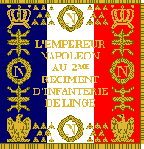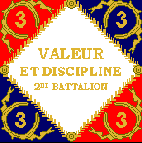
1806 Campaign
Guard and Napoleon.


"Discipline was high, it was forbidden
to brawl at the canteens or get drunk."
.
1. Infantry of the Imperial Guard.
2. Organization.
3. Young Guard
4. Middle Guard
5. Old Guard

|
Infantry of the Imperial Guard.
Guard of the Directory
Consular Guard
Imperial Guard The increase of Guard came in 1810 from the incorporation of the Dutch Royal Guard. By way of welcome, Napoleon reviewed them and afterwards, open barrels of wine were set out for the perspiring Dutchmen. They found it a delicious change from their habitual beer and quaffed mightily - but couldn't carry the unaccustomed tipple. Roaring drunk they whacked one another and chased squealing Parisian women into the dusky groves. The Dutch regiment became 2e Grenadiers before being demoted to being 3e Grenadiers in 1811. In 1810 the Guard was officially divided into Old Guard, Middle Guard and Young Guard. Only the 1er Grenadiers and 1er Chasseurs carried Eagle. The 2e Grenadiers and 2e Chasseurs, and all the regiments of Middle and Young Guard carried fanions. (The voltigeurs carried red and the tirailleurs carried white ones.) Napoleon explained to Berthier (chief of staff) his intentions: "I intend that the Young Guard subalterns and NCOs should rank with those in the line, its NCOs shall be drawn from fusiliers of Middle Guard, and those of fusiliers from the Old Guard. In the line I shall use the Young Guardsmen as corporals and Middle Guardsmen as sergeants. Therefore the best conscripts should go to the Young and Middle Guard. "
In April 1811 a school of drummers was formed for the Guard. It consisted of : The decree issued on July 19th ordered that there would always be 10 men nominated per regiment of line and light infantry for the recruitment of grenadiers, as well as for the chasseurs of the Old Guard. (In cavalry also 10 men per regiment for the Guard).
Commanders:
In 1812 the structure of the Imperial Guard was as follow: A common criticism of the guard was that it drew off the best men from the line and from the conscripts, thereby robbing them of potential sergeants and corporals. But it must be remembered that Napoleon intended that the guard serves as a training ground for the NCOs from the army so the guard functioned as a military school. For example sergeants of the Old Guard were commisioned as the second lieutenants in the line. The Battalion of Instructions was formed in 1811 and was set up to train the Young and Middle Guardsmen as corporals and sergeants for the newly formed regiments. Napoleon wrote: "My Guard should contain cadres for a reserve of 100 battalions. These will require 3.000 sergeants and 6.000 corporals. There are 2.300 Middle Guardsmen and 12.000 Young Guardsmen at present. By holding on to the choice men we can eventually train 3.000 sergeants and 6.000 corporals in the Young Guard".
1812
1813-1814
In 1814 the Guard fought hard at the Battle of Paris. Lieutenant Viaux of 2nd Grenadiers of Old Guard collected 20 soldiers at Montmartre and fought to the end. His body full of wounds was found under a tree, with saber in his hand and surrounded by corpses of dead and wounded Prussians. Near Courbevoie the invalids of Old Guard refused to surrender shouting "The Old Guard has never laid down its arms". The invalides gave up their fight only after had been granted a honorable terms. At Saint-Denis 400 voltigeurs of Young Guard led by Major Savarin refused to surrender to the Russians.
1815
|

The Young Guard
Napoleon gave seasoned officers to command the Young Guard. These veterans forged their men into a superbly drilled and strictly disciplined force. The men of Young Guard were healthy and with stamina (in 1812 the 4th Voltigeurs and 4th Tirailleurs marched 468 miles in 23 days !) In 1809 the height requirement was 163 cm, in 1814 157 cm. The taller of the recruits went into the Tirailleurs-Grenadiers while the shorter ones entered the Tirailleurs-Chasseurs. The martial air of the first regiments of Young Guard astonished everyone. In 1810 the tirailleurs-grenadiers were rebaptized 'tirailleurs'; the tirailleurs-chasseurs had their title amputated to 'tirailleurs'. The conscripts became the 3rd and 4th regiments of tirailleurs and voltigeurs. The regiments of Young Guard had sappers. These men wore tall bearskins and white leather aprons and marched at the head of the regiments. The only problem was with meeting the requirement of having beards by the sappers. Paul de Bourgoing wrote: "Choose the 12 men who seem to have the thickest beards, or are likely to grow them. Above all, don't take any blondes or redheads; only men with black beards, whom you'll place out in front.... Most were still beardless."
The campaign in 1812 in Russia destroyed the Guard. In 1815 the Young Guard was in a poor shape. Only 5 out of 16 regiments were combat-ready. In their ranks served volunteers, Corsicans, and even deserters. Some went out with girls and/or got drunk. Several battalions of Young Guard were under general Lamarque serving in Vendee. He complained that they were filled with recruits and deserters who neither knew how to maneuver nor shoot. (Lasserre - "Les Cent jours en Vendée: le général Lamarque et l'insurrection royaliste, d'après les papiers inédits du général Lamarque." published in 1906.)
Napoleon enlarged the Young Guard several times.
On June 16th 1815 the Young Guard consisted of the following regiments:
|
|

The Middle Guard.
The two regiments were formed in 1806 from veterans with at least 6 years' service. Soon these units were disbanded and in 1810 the regiment of Dutch Guard grenadiers took on the name 2e Grenadiers. The Dutchmen wore white instead of dark blue uniforms. (In 1811 they were renamed to 3e Grenadiers and in 1813 were disbanded.) In 1811 the two original French units were reraised and strengthened with 500 men from the line with 5 years' service and 1.000 men from the instruction battalions at Fontainebleau. Few hundred of veterans were selected from the troops in Spain and sent to join the Middle Guard. Although they looked good with tanned faces, some of them went around and stole things in Paris. General Michel arrested them and sent to prisons. In 1813 they became Old Guard although the army still called them Middle Guard. The first battalions of the two units were made of fusiliers of Middle Guard with 3 years' service. The second battalions were formed of veterans from the line with 8 years' service. The Fusiliers (Fusiliers de la Garde) were formed in 1806 from selected conscripts taken from infantry and from departamental reserve companies. In 1806 the height requirement was 168 cm (soon it was heightened to 173 cm). The NCOs came from the Velites battalions while officers from the Guard grenadiers and chasseurs. In 1807 the 2e Fusiliers had been formed from conscripts. Soon it was renamed to Fusiliers-Grenadiers. Until 1811 both units of Fusiliers were ranked as Young Guard. In 1810-11 Napoleon wrote that the most distinguished and intelligent Fusiliers with 4 years' service or citation for gallantry should be admitted to the Old Guard. Napoleon added: "Thus half or one third of the Fusiliers will be recruited from the Young Guard and conscripts and half or one third of the Old Guard from the Fusiliers." In 1813 approx. 250 battalions from Spain furnished 6 veterans each with at least 4 years' service into the Fusiliers. In 1814 the Fusiliers became Old Guard although Napoleon refused to give them bearskins. The Fusiliers were disbanded after the campaign.
|
|
<

Old Guard
Right picture: private of Old Guard in campaign dress and ready for action, by Vernet.
The Old Guard was the elite of the elite, the creme de la creme of Napoleon's infantry.
You cannot exaggerate about them. They were convinced to the point of arrogance, that they are the most ferocious fighters on earth- and the amusing thing about it is that they were.
If the men of Old Guard had the chance to fight the enemy today in a pub, they would take them to the cleaners then drive them back in a school bus sobbing like the muppets.
The Emperor was proud of their reputation, appearance, and always gave them a prominent place in his great exhibitions at Paris. They occupied the barracks of the Cent-Suisse, nearest the Emperor. Over the door was carved: "The Home of the Brave".
One of the commanders of Old Guard was General Gros.
Napoleon had a very particular regard for him. “Gros, he said, lives in gunpowder like fish in water: it is his element.... He is a finished trooper.” Gros was masculine, very brave but poorly educated, the way in which he expressed himself belonged only to him.
With their wounds, tatoos, and golden earrings, the fearsome legionnaires inspired awe.
Napoleon selected his guardsmen carefully and the requirements were not easy to meet for the candidates. In 1806 only one man from each infantry battalion was admitted to the Old Guard. The requirements were: Only men awarded with Legion of Honor were exempted from height requirement. In 1809 the 1er Grenadiers and 1er Chasseurs took 456 best NCOs from the army, they became privates in the Old Guard. The Guard was in its peak.
There were two regiments of Old Guard. It was the senior regiment of Napoleon's infantry. They were nicknamed "The Grumblers" (Grognards -in French). This name was given in 1807 during campaign in Poland. Napoleon was in a foul humor and gave the complaining on mud, hunger and weather Guardsmen a nickname "The Grumblers". Some had 20 campaigns and more ! Colonels: in 1804 Higonet, 1805-1807 Dorsenne, 1807-1813 Michel, 1813-1815 Petit. The second in seniority regiment of Napoleon's infantry. Although they were shorter than the grenadiers they were gayer, livelier "and more supple". Colonels: in 1804 Gros, 1813 Decouz, Rottenmbourg and then Cambronne, in 1815 Michel, Cambronne and then Pelet. The illiterate Gros was a tall, powerful man, "with a voice like a trumpet." Napoleon once said about him, "Gros lives in the smoke of cannon like a fish in water. It is his element."
In the last campaigns Napoleon increased number of regiments of Old Guard.
|

Sources and Links.
Elting - "Swords around the Throne: Napoleon's Grande Armée"
Lachouque - "The Anatomy of Glory: Napoleon and his Guard ..."
Connelly - "Historical Dictionary of Napoleonic France, 1799-1815"
Chlapowski - "Memoirs of a Polish Lancer" transl. by Tim Simmons
Mansel - "The Eagle in Splendour: Napoleon I and His Court"
Rousselot - "Les grenadiers de la Garde" "Les marins de la Garde"
Dupont - "Napoleon et ses grognards"
"Histoire anecdotique, politique et militaire de la Garde impériale par Emile Marco de Saint-Hilaire."